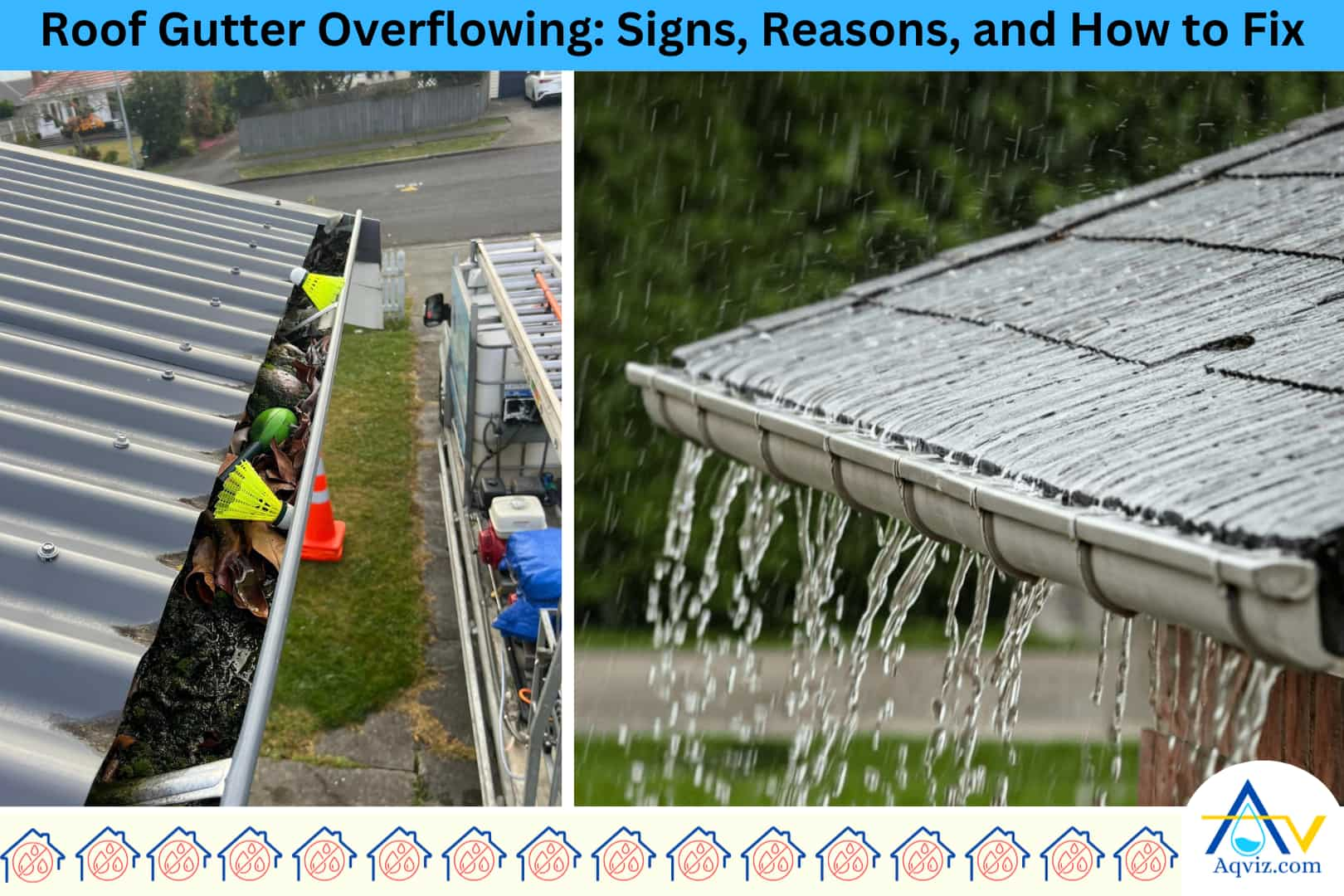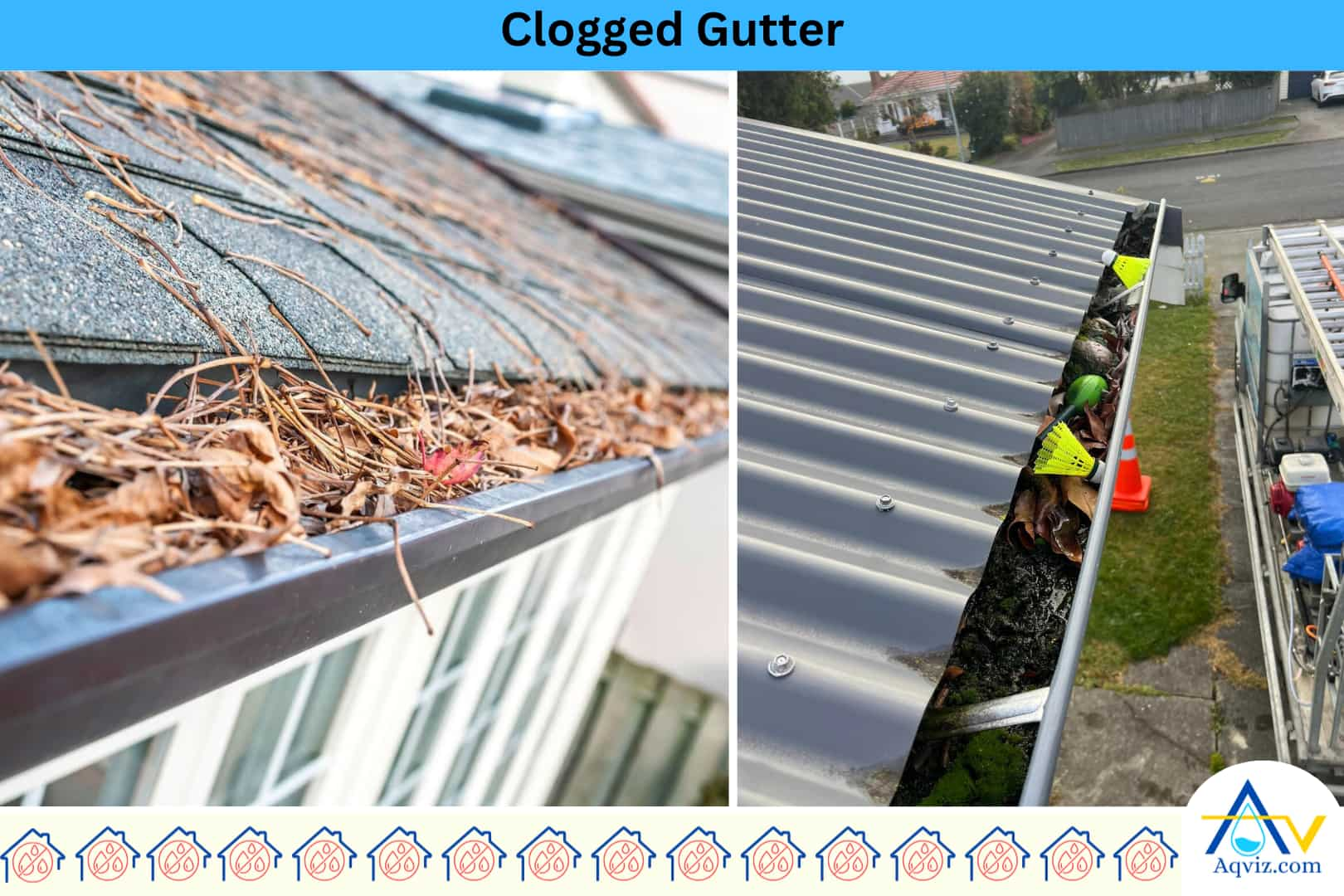Overflowing Gutters: Signs, Reasons, Impacts and How to Fix

Gutter overflowing is a condition when rainwater spills over the edges of a gutter system instead of flowing through the downspouts as intended. A gutter overflows when the volume of water exceeds the flow capacity of the gutter or when obstructions, improper slope, or undersized systems block drainage.
Gutter overflowing occurs due to these 6 reasons, such as clogged gutters, undersized gutters, clogged downspouts, improper gutter pitch, roof valley water surge, and insufficient downspout placement. In some cases, gutters can overflow without any clogging due to incorrect gutter slope, insufficient gutter capacity, and poor downspout distribution. When the gutters overflow continuously, it tends to cause foundation erosion, basement flooding, fascia board flooding, siding discoloration and staining, and damage to the landscape.
So you should stop the gutter overflowing by following the 6 steps mentioned below. And also Aqviz expert suggests you install gutter guards, conduct scheduled maintenance, provide proper downspout sizing, maintain roof valleys and flashing, check the gutter pitch, and divert the runoff away from the foundation to prevent and minimize the effect of gutter overflowing. Contact Aqviz experts; we always support you to protect your property from water damage.

What Is Gutter Overflowing?
Gutter overflowing is a condition when rainwater spills over the edges of a gutter system instead of flowing through the downspouts as intended. Overflowing gutters occur when the volume of water exceeds the flow capacity of the gutter or when obstructions, improper slope, or undersized systems block drainage. The problem is common during heavy rainfall events, especially in spring and fall, when leaf debris, pollen, or ice buildup affects the gutters’ flow efficiency.
K-style, half-round, and box gutters, typically sized between 5 to 7 inches, handle average flow rates between 0.75 to 1.5 gallons per linear foot. However, during intense downpours or storms producing more than 1 inch of rain per hour, these systems often become overwhelmed if not properly maintained. Overflowing gutters frequently affect homes with undersized downspouts, flat roofs, or improper pitch, leading to fascia damage, foundation erosion, and water intrusion into basements or crawl spaces.
Why Do My Gutters Overflow in Heavy Rain?
Gutters overflow in heavy rain due to these 6 reasons such as clogged gutters, undersized gutters, clogged downspout, improper gutter pitch, roof valley water surge, and insufficient downspout placement.
- Clogged gutters : Clogged gutters cause overflow when leaves, twigs, and roof debris block water flow.
- Undersized gutters : Undersized gutters overflow when the gutter width cannot handle intense rainfall. regions.
- Clogged downspouts : Clogged downspouts prevent water from exiting the gutter system. Debris stuck in elbows or narrow pipe openings creates water backup during peak flow.
- Improper gutter pitch : Improper gutter pitch leads to standing water and slow drainage. Gutters must slope at least 1/4 inch per 10 feet toward the downspout to maintain flow.
- Roof valley water surge : Roof valley water surge causes sudden overflow at gutter intersections.
- Insufficient downspout placement : Insufficient downspout placement leaves gutters overwhelmed in long horizontal runs.
Why Do Gutters Overflow Without Clogging?
Gutters can overflow even when there are no visible clogs due to these 3 reasons.
- Incorrect slope : An Incorrect slope prevents water from draining efficiently toward the downspouts. Gutters must have a consistent slope of at least 1/4 inch per 10 feet; otherwise, water pools and spills over during rainfall.
- Insufficient capacity : Insufficient capacity occurs when the gutter size doesn’t match the roof’s water load. A steep or large roof sheds water too quickly for a narrow 5-inch gutter, causing it to overflow during moderate rain.
- Poor downspout distribution : Poor downspout distribution causes water to accumulate in long gutter sections. If downspouts are too far apart or poorly positioned, water backs up and exits over the edge even in the absence of debris.
What Happens If Gutters Overflow?
Aqviz experts have observed that prolonged gutter overflowing causes these 5 problems.
- Foundation erosion : Foundation erosion occurs when overflowing water pools around the base of the house. Over time, this constant saturation weakens the soil and concrete footings, leading to cracks and settlement.
- Basement flooding : Basement flooding happens when excess roof runoff seeps into the ground and penetrates the basement walls. Poor surface drainage from overflowing gutters increases hydrostatic pressure around the foundation.
- Fascia board rot : Fascia board rot develops as water continuously spills over and saturates wooden fascia boards. This leads to wood decay, paint peeling, and eventual gutter detachment.
- Siding discoloration and staining : Siding discoloration and staining are caused by dirty overflow water running down the exterior walls. The minerals, algae, and organic matter in the runoff leave visible marks and promote mold growth.
- Landscape damage : Landscape damage results when intense water flow from gutters washes out mulch, erodes soil, and damages plant roots. Overflowing water destroys garden beds and exposes irrigation systems to surface runoff.

How to Stop Gutters from Overflowing?
To stop gutters from overflowing, Aqviz experts highly recommend you to follow these 6 steps.
- Clean gutters thoroughly : Clean gutters thoroughly to remove leaves, shingle grit, and dirt that block water flow. Use a scoop and hose to flush out the entire channel, especially near downspouts.
- Unclog downspouts : Unclog downspouts by flushing with a garden hose or using a plumber’s snake to clear internal obstructions. Free-flowing downspouts prevent water from backing up in the gutters.
- Adjust gutter slope : Adjust gutter slope to maintain a steady flow toward the downspouts. Ensure a drop of 1/4 inch per 10 feet for proper drainage and no standing water.
- Install additional downspouts : Install additional downspouts on long gutter runs to improve discharge capacity. More exit points help prevent water buildup during heavy rain.
- Seal gutter leaks and joints : Seal gutter leaks and joints using silicone or gutter sealant. Tight, leak-free seams stop water from escaping mid-channel and causing local overflow.
- Upgrade to larger gutters : Upgrade to larger gutters, such as 6-inch K-style systems, if the current ones can’t handle roof runoff. Larger gutters increase flow capacity for steep or large roof surfaces.
How to Prevent Gutters from Overflowing?
To prevent gutters from overflowing, we highly recommend that you should follow these 6 steps. These steps can prevent the gutter from overflowing and reduce the water problems to the structure.
- Install gutter guards : Install gutter guards to block leaves, twigs, and debris from entering the gutter channel. Mesh or screen guards reduce clogging and keep water flowing freely.
- Schedule seasonal cleaning : Schedule seasonal cleaning in spring and fall to clear organic buildup from gutters and downspouts. Regular maintenance prevents blockages before storms arrive.
- Ensure proper downspout sizing : Ensure proper downspout sizing to handle the roof’s runoff volume. A minimum of 2×3 inches is standard, but larger 3×4-inch downspouts improve flow during heavy rain.
- Maintain roof valleys and flashing : Maintain roof valleys and flashing to direct water correctly into the gutter. Poor drainage from valleys causes localized overflow at gutter entry points.
- Check and correct gutter pitch : Check and correct gutter pitch regularly to ensure water moves toward downspouts. Misaligned gutters create pooling and lead to overflow during moderate rain.
- Divert runoff away from the foundation : Divert runoff away from the foundation using splash blocks or underground drain extensions. Managing discharged water helps prevent pooling that backs up into gutters.
Read More About Other Water Problems on the Roof
How to Minimize Gutter Overflow Impacts?
Minimizing the impacts of gutter overflowing involves controlling water discharge and reducing the damage to structural elements. So here are 5 effective ways to reduce the problems caused by gutter overflow.
- Install splash blocks or downspout extenders : Install splash blocks or downspout extenders to direct water at least 3-4 feet away from the foundation. This helps to prevent soil erosion, basement leaks, and foundation weakening.
- Add a gravel drainage bed : Add a gravel drainage bed under roof drip lines or along the foundation to absorb excess water. Gravel slows runoff and reduces surface water pooling.
- Waterproof foundation walls : Waterproof foundation walls with bituminous coatings or drainage membranes. This barrier minimizes water infiltration caused by repeated gutter overflows.
- Grade landscaping away from the house : Grade landscaping with a 5% slope away from the structure to encourage water flow away from the foundation. Proper grading reduces the chance of water re-entering the basement or crawlspace.
- Use rain barrels or diverters : Use rain barrels or diverters to capture and store runoff from downspouts. These systems reduce water pressure on soil and landscaping while conserving water for later use.
